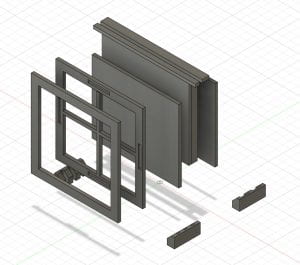Initial Phase
The first idea of our project as depicted below in colour. From research, we have found that general, basic filters normally included a pre-filter, which helped to remove small particulate matter like dust and dirt etc., and a filter that contain charcoal which helps to remove volatile organic compounds like formaldehyde. We imagined our model would include the basic parts of a regular filter which included the pre- and depth filters shown as the first two orange rectangles in Figure 1 below as well as the activated carbon filter shown as the purple rectangle as seen in Figure 1 below. As we have mentioned in the “Working Principle” segment of our blog, we have taken inspiration from wet-scrubbers used industrially to help remove toxic gases and pollution. We used a sponge instead of water as water would require a greater amount of pressure to push the water through the wet-scrubber (and would need a larger and likely more expensive pump which would make the model less affordable) and may cause spillages and pose a risk with the battery operated air pump. It would also not make the filter as portable as we would have liked it to be.
Hence, a summarised version of our filter:
- Pre-filter which we would have liked to be made of surgical masks, which were readily avaible and relatively cheap
- Fine particle filter
- U-turn inspired by the wet-scrubbers used industrially
- Activated carbon filter to remove volatile organic compounds
- Air pump

As seen in Figures 2 and 3 below, this was the broken down version of our parts of our project. The we scrubber was supposed to hang on top of the acrylic box and would hold the sponge (squished in between the two layers).


Prototype
Prototype images/videos with descriptions.
During the planning phase, we decided on a model that would best suit our requirements. However, due to the sheer difficulty of getting the wet scrubber to be printed right, as well the difficulty in getting the acrylic box to be cut specifically at the point where the wet scrubber had to be placed (since it was supposed to be hanged, we had to cut holes in the box to place the part), we had decided to change the design of the wet scrubber to one that simply sat on top of its sides. Stark helped with the refinement of the preliminary design of the project and came up with a new design for the wet scrubber as shown below in Figure 4. Each filter section, both the pre-filter using the surgical mask and the U-turn using the sponge, would be able to slide out and be removed and could be changed (which would help with the sustainability of our project, one of our goals of our project).

As seen in Figure 5 below, a more detailed sketch of our prototype, the pre-filter and U-turn have been modeled with ridges to help with the easy removal of each filter part and its respective material. We printed the sides for each filter to help the filter stay in place (these parts are stuck onto the prototype using the same acrylic glue that we used to glue the acrylic box together). As for the wet scrubber, we printed the sides with an additional height so that the sponge could sit in the space between the two acrylic plates, which were glued onto the prototype. The end was a piece of acrylic and cut by a laser cutter to achieve the circle in the center. This part was to be connected to our air pump.
We had finally finished building our first prototype as shown below, in the image.
Final Product
Final Product images/videos with descriptions.